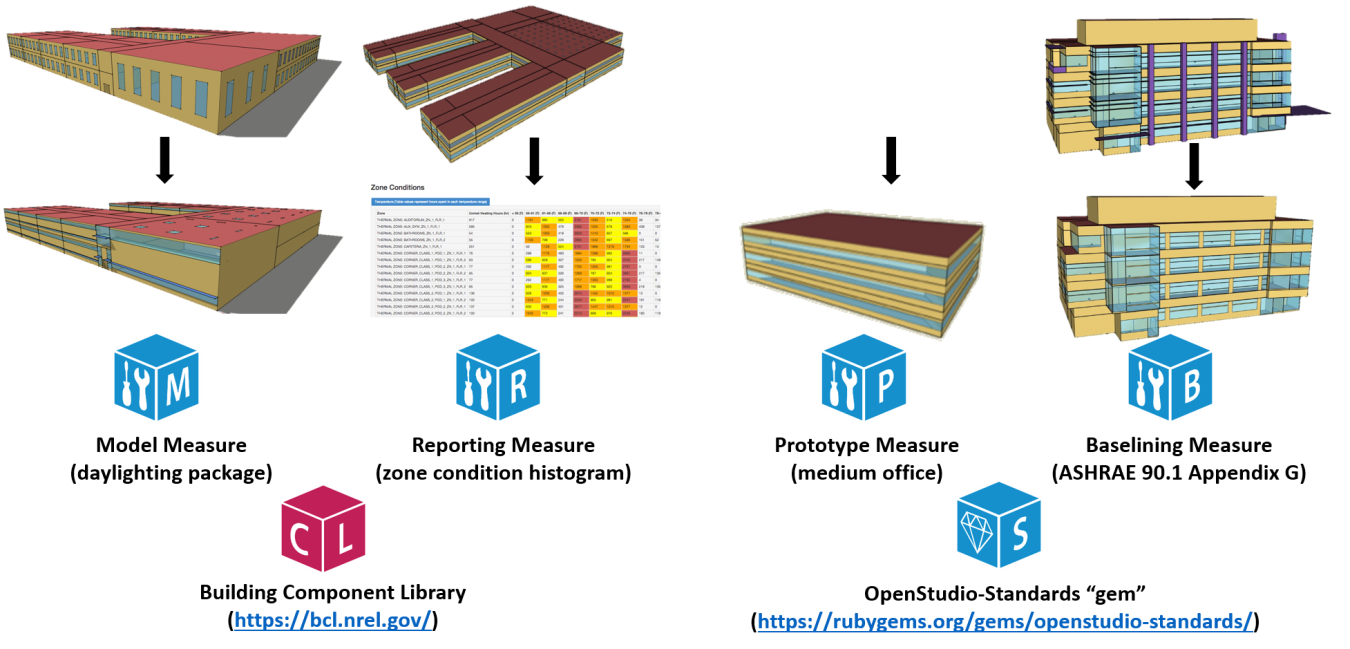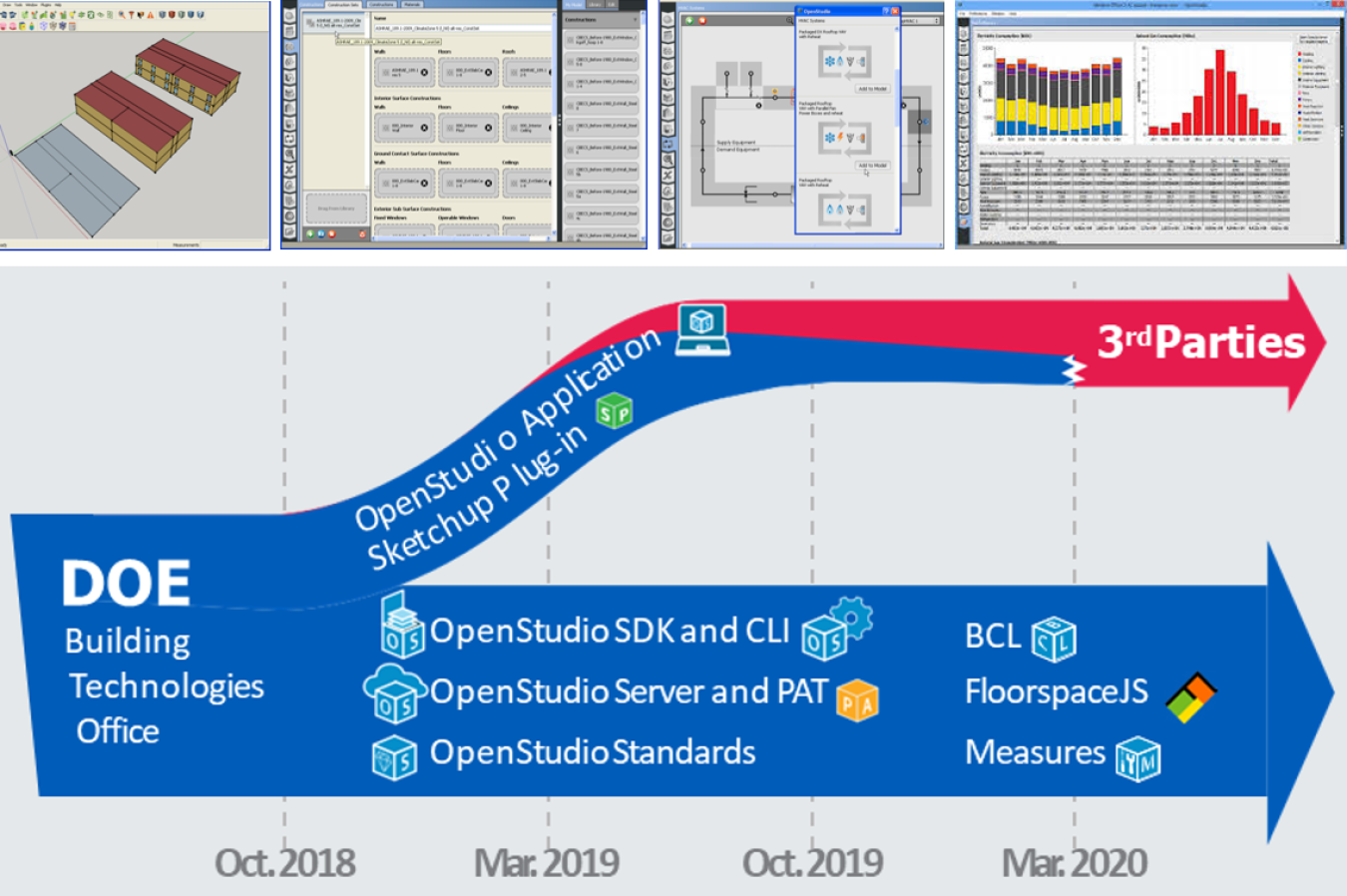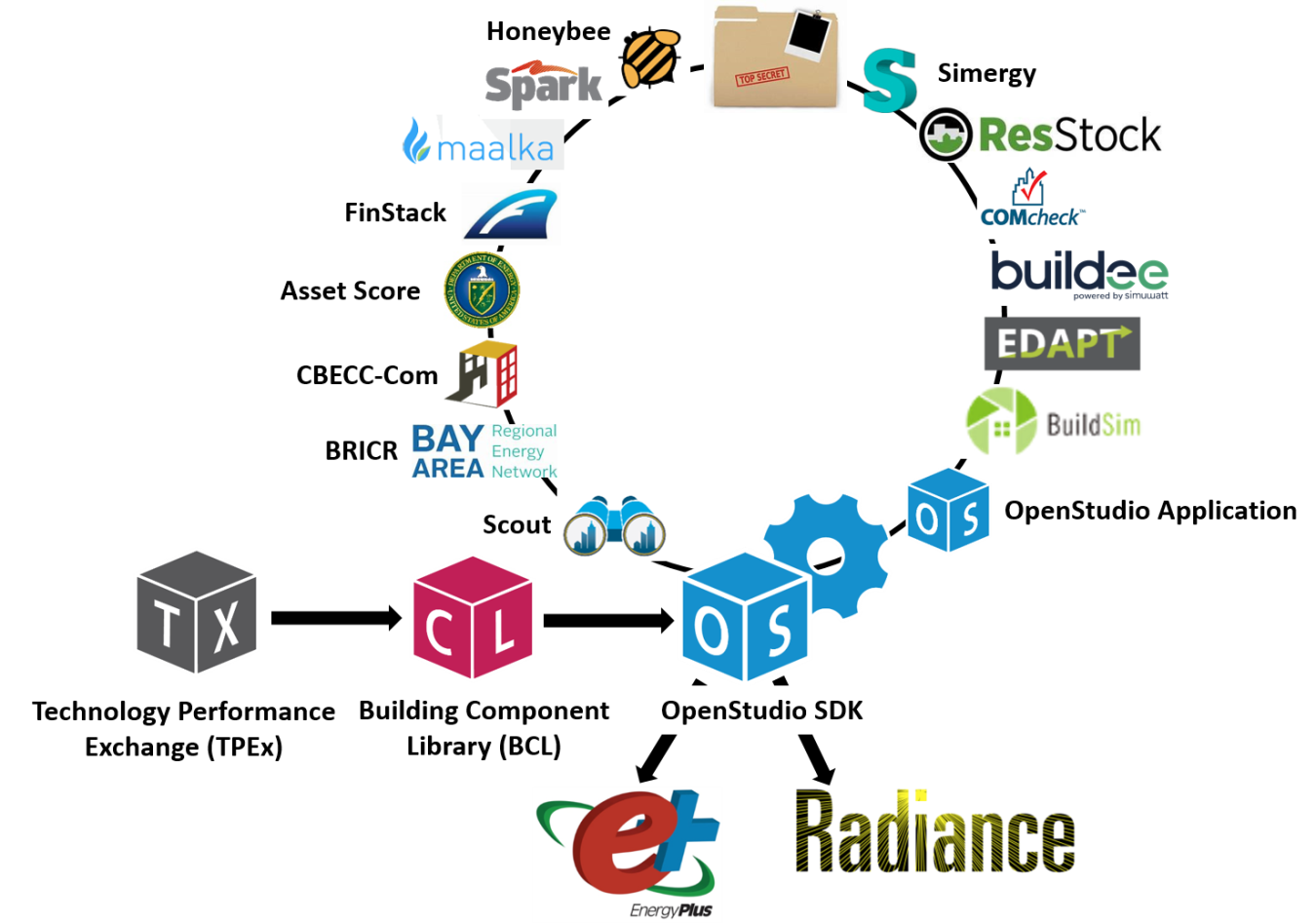OpenStudio is an open-source software development kit (SDK) for energy modeling with EnergyPlus.
August 28, 2014Project website: http://openstudio.net/
Performers:
-- National Renewable Energy Lab (NREL) – Golden, CO
-- Argonne National Lab (ANL) – Argonne, IL
-- Lawrence Berkeley National Lab (LBNL) – Berkeley, CA
-- Oak Ridge National Lab (ORNL) – Oak Ridge, TN
-- Pacific Northwest National Lab (PNNL) – Richland, WA
-- GARD Analytics – Oak Park, IL
-- Empty Crate Software – Denver, CO
DOE Funding: $1,560,000 in FY17; $9,360,000 to date
Cost Share: $7,011,000 to date
Project Term: 2011 –
Funding Opportunity: Emerging Technologies and Commercial Buildings Integration core funding
Related projects: EnergyPlus, Spawn of EnergyPlus, Radiance, Asset Score, BayREN, CBERD, Scout, BEOPT, BuildingSync, ResStock
PROJECT OBJECTIVE
OpenStudio is an open-source software development kit (SDK) for building energy modeling (BEM). OpenStudio is a developer’s platform aimed at dramatically reducing the effort required to build and maintain applications that use BEM and is aimed at growing and supporting the ecosystem of end-user BEM tools and services.
OpenStudio allows third parties to focus on adding individual differentiating value and on serving their clients by providing common core infrastructure. BEM engines like EnergyPlus interact with applications via large, static, and sometimes cumbersome files. OpenStudio facilitates application development by presenting EnergyPlus inputs and outputs as a dynamic, object oriented data model with application programming interface (API), a much easier construct for applications to deal with. In addition to low-level model and result access, OpenStudio also provides common high-level abstractions like space types and spaces and functionality like instantiation and configuration of standard HVAC systems, and data import from standard schemas like gbXML. Finally, in addition to EnergyPlus, OpenStudio also exports inputs for and import results from other engines like the Radiance lighting engine and the CONTAM airflow engine, supporting multiple analyses from a single model.
OPENSTUDIO MEASURES
The OpenStudio platform enables workflow automation via a distinctive feature called Measures. Measures are small interpreted programs that can transform a model, or query a model and its simulation results. Measures—named so because many of them correspond to energy-conservation measures (ECMs)—can perform transformations that are as simple as changing insulation levels or as complex as reconfiguring fenestration, shading, and controls to optimize for daylight harvesting. Measures are lightweight, easy to create and modify, and provide a way to customize OpenStudio and its capabilities without having to modify the core SDK. Beyond enabling parametric analysis—the systematic application of measures to a model in various combinations—measures dramatically reduce the effort required to construct energy models, while improving their consistency and quality. Over 200 Measures are already available on the Building Component Library (BCL), an online repository of OpenStudio content. Many more are currently in development. One recently developed and especially powerful measure is “Create Performance Rating Method Baseline Building Model” which automates the ASHRAE 90.1 “Appendix G” baselining procedure that is at the heart of both code-compliance and above code BEM applications LEED and energy-efficiency incentive documentation. Automating this procedure eliminates tedious modeler effort and frees up time and budget for more creative and productive activities like evaluating energy-efficiency strategies.


LARGE SCALE ANALYSIS WITH OPENSTUDIO
One focus of the OpenStudio project is support for large-scale analysis, including design optimization, model input calibration, building stock analysis to identify buildings that are candidates for specific programs, or prototype analysis to develop typical savings values. There are two aspects to this—support for cloud computing, and the use of Measures to systematically and efficiently create and index large simulation spaces consisting of related model variants. The cloud provides cheap on-demand processing resources. OpenStudio, and specifically Measures, allow these resources to be used productively.

OPENSTUDIO APPLICATION
The OpenStudio project includes a graphical application for creating and editing models, running simulations, and viewing results. In line with its stated goal to support BEM application developers and service providers, BTO has announced that it will be transitioning the OpenStudio Application and SketchUp plug-in to one or more third parties by April 2020. More information about this transition plan, including answers to some frequently asked questions and contact information for additional questions, is available on the OpenStudio site.

TRAINING AND TECHNICAL SUPPORT
The recently published book "Building Energy Modeling with OpenStudio" provides a good introduction to the OpenStudio Application and the general modeling process, complete with exercises.
The OpenStudio website includes documentation and training videos. If you are interested in live instructor-led training, there are in person and online offerings from several organizations.
For technical support questions, please search the public Q&A site Unmet Hours for an existing answer to your question. If one is not found, please post your question to the site, being sure to include "openstudio" as one of the tags. Both the OpenStudio development team and the larger OpenStudio user community monitors this site.
PROJECT IMPACT
The OpenStudio project has more than 40,000 registered users. More importantly, a diverse range of end-user applications and services have already been developed on it. These include public sector tools like CEC's CBECC-Com for Title 24 compliance and private sector tools such as the Honeybee energy modeling plug-in for Rhino/Grasshopper.

CONTACTS
DOE Technology Manager: Amir Roth
Project Manager: Luigi Gentile Polese, NREL
RECENT PUBLICATIONS AND PRESENTATIONS
- “City Scale Modeling with OpenStudio,” SimBuild 2016, Salt Lake City, UT, August, 2016.
- “OpenStudio: A Platform for Ex Ante Incentive Programs,” ACEEE Summer Study on Energy Efficiency in Buildings, August 2016.
- “Scout: An Impact Analysis Tool for Building Energy-Efficiency Technologies,” ACEEE Summer Study on Energy Efficiency in Buildings, 2016.
- “Electronic Auditing Tool with Geometry Capture,” DoD ESTCP Report EW-201260, 2015.
- “A Graphical Tool for Cloud Based Building Energy Simulation,” SimBuild 2014, Atlanta, GA, September 2014.
- “Scaling Building Energy Modeling Horizontally in the Cloud with OpenStudio,” SimBuild 2014, Atlanta, GA, September 2014.
- “A Parametric Analysis Tool for Building Energy Design Workflows: Application to a Utility Design Assistance Incentive Program,” ACEEE Summer Study, August 2014.
- “Cloud-Based Model Calibration Using OpenStudio,” eSim 2014, Ottawa, Canada, May 2014, http://www.nrel.gov/docs/fy14osti/61420.pdf.
- “OpenStudio”, Larry Brackney, 2014 BTO Peer Review, Apr. 22, 2014, Arlington, VA.
- “NREL’s OpenStudio Helps Design More Efficient Buildings,” Innovation Impact Factsheet, July 2014, http://www.nrel.gov/docs/fy14osti/62338.pdf.
- “Computing Advances Enable More Efficient Buildings,” NREL Continuum, March 2014, http://www.nrel.gov/continuum/homes_buildings/computing.html.
- “NREL Brings Precision, Savings to Energy Audits,” NREL Press Release, October 2013, https://www.nrel.gov/news/features/2013/4300.html

